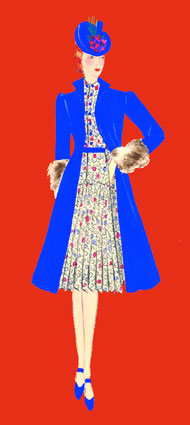 Jewish fashion designers like Isaac Mizrahi and Michael Kors have become household names in contemporary fashion, but one Jewish designer never had a chance to make an impact on the fashion world, because she died during the Holocaust.
Jewish fashion designers like Isaac Mizrahi and Michael Kors have become household names in contemporary fashion, but one Jewish designer never had a chance to make an impact on the fashion world, because she died during the Holocaust.
Hedy Strnad, a talented dressmaker in Prague in the 1930s, was not able to escape Nazi-occupied Czechoslovakia. However, some of her fashion designs did. Eight of her sketches, along with the garments they inspired, are the focus of “Stitching History From the Holocaust,” an original exhibit created by and on loan from Jewish Museum Milwaukee that will be shown at the University of Alabama at Birmingham.
“Stitching History From the Holocaust” will be on display from Jan. 7 through March 16, 2019, in the College of Arts and Sciences’ Abroms-Engel Institute for the Visual Arts presented by the Birmingham Holocaust Education Center. An opening reception, free and open to the public, will be from 6-8 p.m. Friday, Jan. 11, at AEIVA.
The BHEC is partnering with the University of Alabama at Birmingham, the University of Alabama, AEIVA, UAB’s Alys Stephens Performing Arts Center, Birmingham Jewish Foundation and Red Mountain Theatre Company to present programming, including gallery talks, a fashion show of her designs and a play, in conjunction with the exhibit. Docent-led tours will be available.
In March 1939, Hitler’s army invaded Czechoslovakia, and the worst fears of Czech Jews became reality. In December, Hedy’s husband, Paul, wrote to his cousin in Milwaukee asking for help in acquiring visas for himself and his wife to emigrate to the United States. “You may imagine we have a great interest of leaving Europe as soon as possible,” Paul wrote. He included eight samples of Hedy’s dress designs to make the case that she would be employable in the American apparel industry. Sadly, the cousin’s efforts to help Paul and Hedy emigrate were unsuccessful, and the couple perished during the Holocaust.
For decades, the letters and Hedy’s sketches were stored away in a box in the cousin’s attic, where they were discovered in 1997. They were donated to Jewish Museum Milwaukee, which teamed with the costume shop at Milwaukee Repertory Theater to turn the sketches into garments. “Stitching History from the Holocaust” is a detailed personal and historical exhibit built around the Strnads’ story, their life in Prague in the 1930s and Hedy’s garments, which are displayed on mannequins.
“The stories of the Holocaust are stories of loss,” said Deborah Layman, president of the Birmingham Holocaust Education Center. “Hedy’s story represents the loss of a talented woman whose creative life was cut short. Her story is one of the millions of heartbreaking Holocaust stories that we tell and re-tell as a reminder of the consequences of hate.”
Additional scheduled programming for the exhibition includes:
- Tuesday, Jan. 22, 6 p.m., Gallery talk at AEIVA: Kristen Miller Zohn, executive director of the Costume Society of America, will speak on "European Jewish Fashions in the 30s and 40s: How the Jewish Fashion Industry Was Extinguished by the Nazis and Struggled to Return to Prominence After the War.
- Tuesday, Feb. 5, noon, Gallery talk at AEIVA: Jonathan Wiesen, Ph.D., incoming chair of the UAB CAS Department of History, will speak on “The Holocaust in Czechoslovakia” at AEIVA.
- Sunday, Feb. 17, 2 p.m. and 4 p.m., Red Mountain Theatre Company will present two performances of “A Stitch in Time,” a one-act play by Susan Westfall based on Hedy’s story, at UAB’s Alys Stephens Center.
- Tuesday, March 5, 6 p.m., Gallery talk at AEIVA: Janek Wasserman, Ph.D., history professor at UA, will speak on “Immigration Then and Now.”